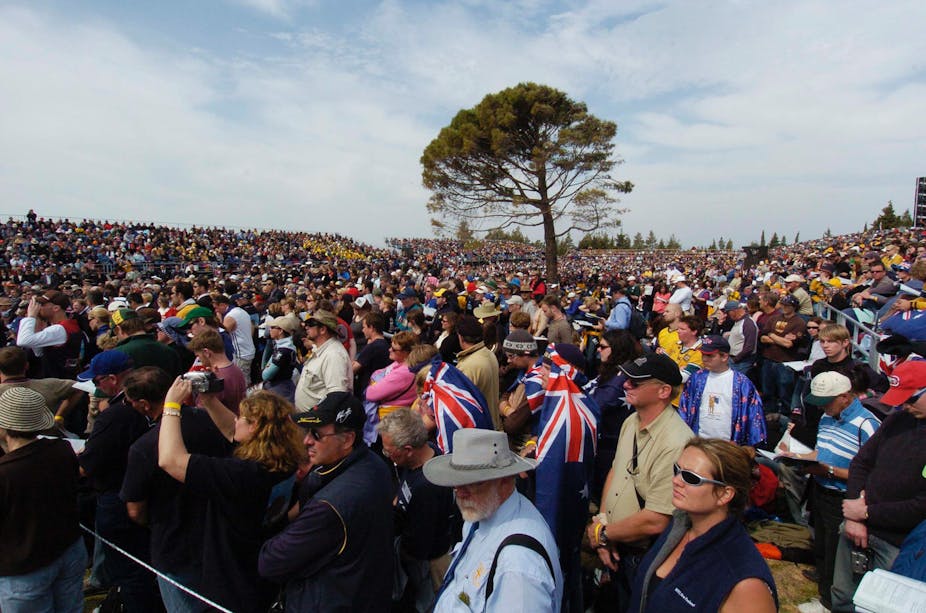Every year since the early 1990s, thousands of visitors have invaded the Gallipoli battlefield.
The rise of this sad, starkly beautiful and melancholy place as a tourist destination is of course related to the battle for Gallipoli in 1915.
Since numbers peaked at nearly 15,000 for the 95th anniversary attendances in 2005, the Anzac Gallipoli ceremonies have been steady at between 7,000 and 10,000.
All in all, it’s a historic development in Gallipoli tourism. And it’s placing pressures on the Gallipoli environment.
Waking the dead
For 90 years or so before the anniversary, the battlefield had remained largely untouched, undeveloped and protected by both Turkish gazetting as a National Park and the conservation concerns of the Commonwealth War Graves Commission.

But it came under great pressure for change. Better access and roads were needed to deal with the numbers.
A more expansive commemorative site for the annual Dawn Service was built in 1999 at North Beach as the service was moved from the Anzac South Beach Cemetery, which had been overwhelmed by the visitor numbers.
But these redevelopments had their toll.
In 2005, when new road-widening and building were carried out, reports soon arose of human bones being dug up and the destruction of sites of historical significance.
The effects of nature’s erosion were suddenly and greatly supplemented and accelerated.
Serious damage resulted at Anzac, the beach was filled with spoil to almost half its width.
Significant sites of Anzac action disappeared, including trench remains at Lone Pine and Quinn’s Post. The Senate inquiry into the issue concluded that the new roads and car parks had “damaged permanently” Anzac’s military heritage.

Historian Bill Gammage has asked the question, “Should Anzac Day be allowed to destroy Anzac?”
He concluded that it was “a dilemma no-one could solve: Anzac could not be made bigger, yet every April more visitors came.”
The question looms greater again as the centenary approaches.
Managing the masses
As well as Australians and New Zealanders, Turkish visitors now attend the expanded Anzac Day ceremonies at Gallipoli each year and arrive regularly throughout the rest of the year.
Managing the battlefield is exercising the minds of Australian officials and Turkish authorities balancing local and national interests.
Guardianship of the Anzac phenomenon has become so sensitive that in recent years the Department of Veterans’ Affairs has appointed a dedicated Gallipoli Counsellor to the Australian Embassy in Ankara.
This official’s job is to maintain effective liaison with Turkish authorities involved in the organisation of the annual ceremonies and the maintenance of the commemorative sites.
This includes the thorny problem of road access and transport arrangements. Anzac Cove was top of the significance list in former Prime Minister John Howard’s Environment Protection and Biodiversity Conservation Act 1999.
There have been major changes to the commemorative sites and transport and security arrangements have a profound impact on the integrity of the battlefield landscape.
A local attraction
Local tourism operators have responded with plans for expanding development and operations as this new chapter in the Gallipoli saga has opened.

The new story features the 1.5 million Turkish visitors a year (as of last year, a figure that’s rising).
Turkish authorities have been active in a number of areas, from constructing new monuments on the battlefield to ensuring the Turkish Gallipoli story reaches all school students.
There is now detailed coverage of the Dardanelles battles in national Turkish school curricula and a stipulation that every Turkish school student will make an organised excursion to the Gallipoli battlefield at least once.
This explains the hundreds of packed Turkish tour buses that arrive each weekend on the Peninsula to lumber along the narrow sloping and winding roads to the various cemeteries. This causes major pressure on the battlefield surface and congestion.
The effect of these Turkish elements meeting up with Anzac tourism has had a profound effect on the landscape.
A Gallipoli Campaign theme park?
The battlefield terrain has already taken on the appearance of a monument park where it used to be one of the world’s least changed sites.
New, substantial and prominent Turkish memorials have been built nearby those of the Allies and in some cases, side by side, such as the great statue of Mustafa Kemal (Ataturk) erected alongside the older New Zealand cenotaph on the Chunuk Bair hill.
Mock Turkish cemeteries have been laid out, some with high monuments and statues, none containing the bodies of the fallen, but acting as memorials.
All these structures give a focus for the Turkish visitors and local souvenir vendors.
Enough is enough
Whatever its future, it is certain that with the Gallipoli centenary due in 2015, Anzac Cove and its surroundings will remain a main attraction for a decade or more.
The battleground needs protection from future degredation and damage, not exploitation.
Enough is enough. Destruction and over-monumentalising will benefit no one, certainly not the unfound dead of all combatant sides lying in unmapped graves and those who wish to honour their memory.
The Anzac Day services should be moved away immediately to a nearby but more manageable area.
Then, without hosting mass commemorations, the Anzac area can be restored to relative peace.

